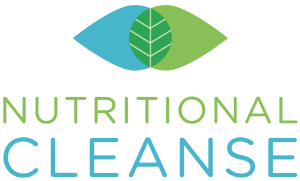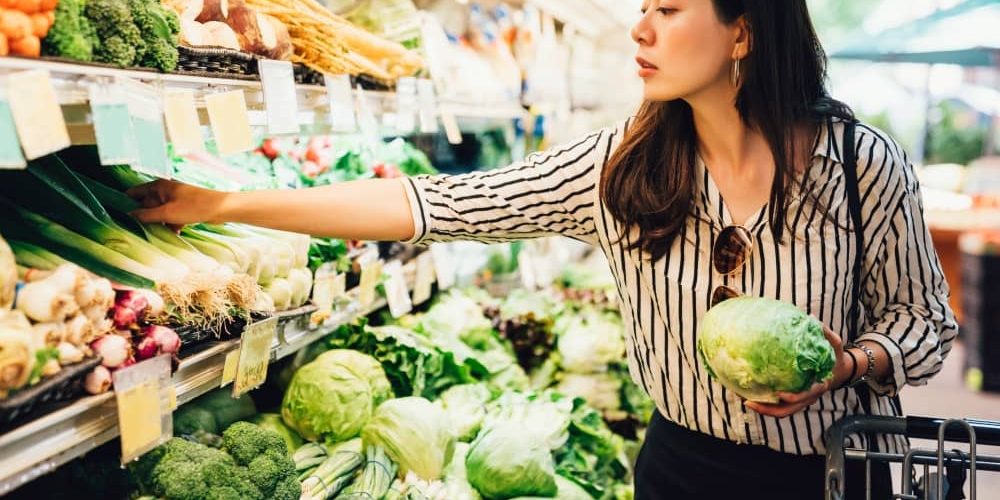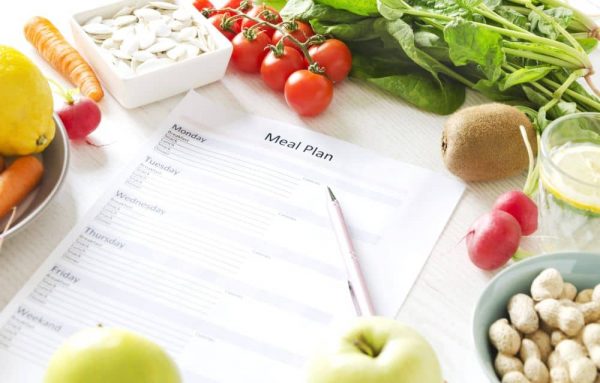Ideas for a Healthy Grocery Shopping List
With so many tempting junk foods, confusing ingredient labels, misleading packaging labels, and endless choices, trying to buy healthy groceries can be stressful and overwhelming for many people.
We’ve put together a guide to healthy grocery shopping to help you plan your shopping list, choose nutrient-dense foods, and help you feel confident about what you buy.
If you get side-tracked, overwhelmed, or end up choosing junk foods instead of whole foods in the store, having a weekly meal plan or set grocery list can help you stay focused and save time.
Studies show that having a grocery list can help you choose healthier items while grocery shopping.
In general, a healthy, balanced diet should feature a variety of whole, nutrient-dense foods such as veggies, fruits, high-quality protein sources, whole grains, beans, seeds, and nuts.
You can create your healthy shopping list based on categories of foods (i.e. fruits, vegetables, grains, proteins) or where certain items are located within the store.
Here’s an example of a healthy grocery list and what it might include:
- Proteins – Eggs, fish, chicken, ground turkey, salmon, tuna, and tofu
- Fruits – Apples, oranges, kiwis, plums, bananas, grapefruits, berries, lemons, avocados, and pineapples
- Non Starchy vegetables – Spinach or other leafy greens, cauliflower, onions, asparagus, sweet peppers, garlic, leeks, bell peppers, mushrooms, and broccoli
- Starchy vegetables – Sweet potatoes, potatoes, and winter squash
- Nuts and Seeds – Almonds, natural nut butters, chia seeds, hemp seeds, pumpkin seeds, macadamia nuts, walnuts, Brazil nuts, pistachios
- Grains and Legumes – Oats, quinoa, brown rice, lentils, chickpeas, dried beans, farro, millet, buckwheat, and barley
- Canned Foods – Sardines, canned salmon, canned pureed pumpkin, canned beans, diced tomatoes, sun-dried tomatoes, canned vegetables, and marinara sauce (look for one with no added sugar)
- Dried Spices – Turmeric, cumin, cinnamon, garlic powder, basil, rosemary, oregano, curry powder, and paprika
- Oils and Condiments – Avocado oil, olive oil, salsa, salad dressing, apple cider vinegar, balsamic vinegar, maple syrup, honey, and pesto
- Beverages – Herbal tea, ground coffee, sparkling water
- Dairy or Dairy Alternatives – Feta cheese, goat cheese, full-fat Greek yogurt, unsweetened yogurt, cheddar cheese, coconut yogurt, and nut milk
- Healthy Snack Foods – Dark chocolate (at least 70% cocoa content), trail mix, hummus, unsweetened dried fruit
- Frozen Foods – Frozen berries, frozen kale, and frozen veggies
Consider Meal Planning to Make Grocery Shopping Easier
If you enjoy meal prepping, you can simply print off the recipes you’ll be making for the week and use the ingredients as a general grocery shopping list.
However, if you are new to meal prepping, it may not be realistic to suddenly try to plan all of your meals and snacks. If you are just learning to meal prep, start slowly by aiming to make one or two meals ahead for the week and build from there once it becomes part of your routine.
How To Cut Down on Trips to the Grocery Store
While fresh items like fruits, veggies, perishables, and dairy products need to be purchased more often, nonperishable goods are worth stocking up on to reduce the frequency of your grocery trips.
Check your fridge, freezer, and pantry often to check on any essentials you are running low on. Along with cutting back on trips to the grocery store, stocking up on healthy pantry staples and frozen foods ensures you always have nutritious ingredients available to prepare a last-minute healthy meal or snack.
For a detailed look at healthy foods to stock up on, check out our blog on “20 Healthy Foods You Should Always Keep in Your Pantry”.
Tips for Healthy Grocery Shopping
Here are some additional tips for healthy grocery shopping:
- Stick to your weekly meal plan as a guide or follow a detailed grocery shopping list
- Read nutrition and ingredient labels carefully
- Skip the urge to purchase an item based on its claims or packaging
- Prioritize nutrient-dense, whole foods
- Aim to avoid impulse purchases
- Do not shop on an empty stomach
- Stay away from junk foods targeted at children (i.e. cereals with cartoon characters on the front)
- Steer clear of foods that contain ingredients you can’t pronounce
- When buying canned fish, lean meat, or chicken, opt for no-salt-added or low-sodium items packaged in water instead of oil
- Opt for canned veggies labeled no-salt-added or lower sodium
- If buying canned fruits, choose items canned in natural juice or water and free of added sugar
Knowledge Is Powder: Learn the Grocery Store Layouts
The majority of grocery stores are strategically set up to put certain items front and center. Spoiler: These items are usually not healthy choices.
Next time you are at the grocery store, pay attention to how it is structured. Often, you can spot large displays of junk food (candy, baked goods, refined snacks, sodas) with big displays and sale prices in prominent locations throughout the store. These are typically located near checkout counters, the front of the store as you walk in, or at the end of aisles.
Having a plan and being aware of these ‘junk food traps’ can help you stick to your list and avoid unhealthy impulse purchases.
Healthier food choices can often be found around the perimeter of the grocery store and in the center aisles. Still, some aisles contain a mix of highly processed items alongside healthier choices.
While you don’t need to avoid entire aisles, it is important to learn your grocery store’s setup so you can shop with awareness. Generally, it works well to fill your cart along the store’s perimeter before moving to the inner aisles.
Always Read the Ingredient Labels Closely
Packaged items aren’t always unhealthy, but it is still important to pay close attention to ingredient lists. Even seemingly nutritious foods can be hiding a surprising amount of added sugar, ingredients you cannot pronounce, or additives.
Be especially careful of assuming that products labeled “gluten-free”, “sugar-free”, or “organic” are automatically healthy. Many of these foods are still heavily processed, contain preservatives or artificial sweeteners, or feature highly processed oils.
Try to opt for items with short ingredient lists, ingredients that are easy to pronounce, and low on added sugar or sodium.
Don’t Be Afraid to Buy a Treat Now and Then
While a balanced diet should focus heavily on fresh ingredients, whole foods, and a variety of fruits and vegetables, don’t forget that the keyword is ‘balanced’. Being too strict and feeling like you have to completely avoid certain foods can set you up for a dietary disaster.
Instead, if you are craving a certain snack such as cookies or chips, add it to your grocery list! The key is planning rather than buying on impulse and opting for the majority of your groceries to be nutritious, fresh, whole foods.
Want More Tips on Eating Healthier?
We hope our list of healthy grocery shopping tips helps take some of the stress out of your next grocery trip. Stocking up on healthy ingredients for your pantry and freezer, sticking to a grocery list, and planning can make a significant difference when grocery shopping and sticking to a healthy diet.
For more tips on eating healthy, the most nutritious foods, the best exercises, natural products, and much more, check out our regularly updated blog. Or, feel free to reach out to our team of health experts for customized product advice.











